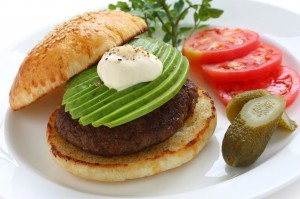By Sayer Ji
Contributing writer for Wake Up World
There are good fats, and then there are not so good fats … but it is a bit more complex than that.
Some good fats can do bad things (go rancid), and sometimes, a fat will sacrifice its goodness to keep another fat from doing harm.
Take for example, a recent study that looked at what happened when avocado was added to a heart-stopping American favorite, the hamburger meal.[i]
Researchers at the UCLA Center for Human Nutrition took eleven healthy subjects, and on two different occasions, fed them either 250 gram hamburger patty alone (ca. 436 cal and 25 g fat) or together with 68 grams of avocado flesh (an additional 114 cal and 11 g of fat for a total of 550 cal and 36 g fat).
The researchers then measured the degree of vasoconstriction following hamburger ingestion 2 hours later in test subjects given a hamburger meal either with our without avocado. The hamburger meal resulted in significant vasoconstriction, whereas the avocado + hamburger meal saw no change at all.
Next, the researchers isolated peripheral blood mononuclear cells from the test subjects in order to measure a protein known as Ikappa-B alpha, which is an indicator of inflammation. At 3 hours, there was a significant preservation of IkBa when avocado was consumed with the meat compared to meat lone, “consistent with reduced activation of the NF-kappa B (NFκB) inflammatory pathway.” Another blood marker, interleukin-6 (IL-6), increased significantly at 4 hours after the consumption of the hamburger, but no change was observed when avocado was added.
Finally, researchers found that post-meal triglycerides did not raise in the avocado group, despite the additional fat, whereas they did increase in the hamburger alone group. The researchers concluded: “These observations are suggestive of beneficial anti-inflammatory and vascular health effects of ingesting added Hass avocado with a hamburger patty.”
Discussion
There are two main reasons why fats are labeled “bad.” First, fatty foods that are comprised of a disproportionate amount of omega-6 fats (relative to omega-3 fats) contribute to the formation of pro-inflammatory eicosanoids, e.g. prostaglandin E2, leukotriene, thromboxane, etc. Corn, soy, peanut, grape, canola, and many other grain, seed and bean oils, are all extraordinarily high in omega-6 relative to omega-3 content. Peanut oil, for instance, has several thousand times more omega-6 than omega-3.
This is profoundly out of balance when you consider our evolutionarily-determined ideal ratio is closer to a 1:1-1:4 ratio of omega-6 to omega-3. When you feed cattle on these omega-6 rich foods, the problem only becomes more exaggerated. Grain-fed cattle not only concentrate omega-6 fats in their flesh but inflammatory metabolites of omega-6 fats such as arachadonic acid, which is the fuel the Cox-2 enzyme “burns” (technically oxidizes) during the inflammatory process. This explains why the ordinary grain-fed hamburger can be so inherently toxic. And yet, there are grass-fed and organic alternatives much higher in beneficial omega-3 fats, as well as beneficial fats such as conjugated linoleic acid (CLA).
But even in this latter case, when the ratio and types of fats are generally “good,” they can still undergo a process known as lipid peroxidation. This is the second way that fats can “go bad.” Lipid peroxidation can occur both outside of the stomach (when grilled/cooked), or within the stomach during the normal process of digestion. Otherwise known as rancidity, lipid peroxidation results in quite a few adverse health effects, including inflammation and even damage to the arteries in our bodies. This is why antioxidants, as evidenced by avocado’s beneficial role in the study above, are powerful inhibitors of this deleterious process.
Ultimately, this study speaks to the necessity of balance in what we eat. Recipes, as we have written about previously in Have We Stripped Our Food of Its Story?, are “medical prescriptions,” which is the literal translation of the French word. Our common use of dressings, condiments and spices, in other words, are not simply aesthetical enhancements to our meals, but protect and amplify the nutrition contained within the main ingredients.
For those who have chosen a meat-based diet for themselves, the key may be making sure that the animals were raised in as humane and healthy a manner as possible, and that when consuming meat they also consume antioxidant spices, seasonings and plant foods that prevent it from going rancid or otherwise doing harm.
For an extensive list of over 50 natural compounds which reduce or eliminate lipid peroxidation view GreenMedInfo’s research section on the topic: Lipid Peroxidation Research.
Article Sources:
- [i] Zhaoping Li, Angela Wong, Susanne M Henning, Yanjun Zhang, Alexis Jones, Alona Zerlin, Gail Thames, Susan Bowerman, Chi-Hong Tseng, David Heber. Hass avocado modulates postprandial vascular reactivity and postprandial inflammatory responses to a hamburger meal in healthy volunteers. Food Funct. 2012 Nov 29. Epub 2012 Nov 29. PMID: 23196671
Recommended articles by Sayer Ji:
- Brain Regeneration: Why It’s Real and How To Do It
- Research: Garlic is an Effective Natural Treatment for Heart Disease
- Wi-Fi Devices Increase Mercury Release From Dental Amalgams
- Mammography Is Harmful and Should Be Abandoned, Scientific Review Concludes
- “Killer Germs” Obliterated by Medicinal Smoke Smudging, Study Reveals
- Turmeric’s ‘Smart Kill’ Properties Put Chemo & Radiation To Shame
- Beet Juice Boosts Cognitive Function In One Dose
- The Amazing Healing Properties of Apples
- 6 Bodily Tissues That Can Be Regenerated Through Nutrition
- How to Clean Your Arteries With One Simple Fruit
About the author:
Sayer Ji is the founder of Greenmedinfo.com, a reviewer at the International Journal of Human Nutrition and Functional Medicine, Co-founder and CEO of Systome Biomed, Vice Chairman of the Board of the National Health Federation, and Steering Committee Member of the Global Non-GMO Foundation.
For more, visit GreenMedInfo.com and Facebook.com/GreenMedInfo, or sign up for GreenMedInfo’s free e-Newsletter.
© GreenMedInfo LLC. This work is reproduced and distributed with the permission of GreenMedInfo LLC. Want to learn more from GreenMedInfo? Sign up for their newsletter here.

If you've ever found value in our articles, we'd greatly appreciate your support by purchasing Mindful Meditation Techniques for Kids - A Practical Guide for Adults to Empower Kids with the Gift of Inner Peace and Resilience for Life.
In the spirit of mindfulness, we encourage you to choose the paperback version. Delve into its pages away from screen glare and notifications, allowing yourself to fully immerse in the transformative practices within. The physical book enriches the learning process and serves as a tangible commitment to mindfulness, easily shared among family and friends.
Over the past few years, Wake Up World has faced significant online censorship, impacting our financial ability to stay online. Instead of soliciting donations, we're exploring win-win solutions with our readers to remain financially viable. Moving into book publishing, we hope to secure ongoing funds to continue our mission. With over 8,500 articles published in the past 13 years, we are committed to keeping our content free and accessible to everyone, without resorting to a paywall.








